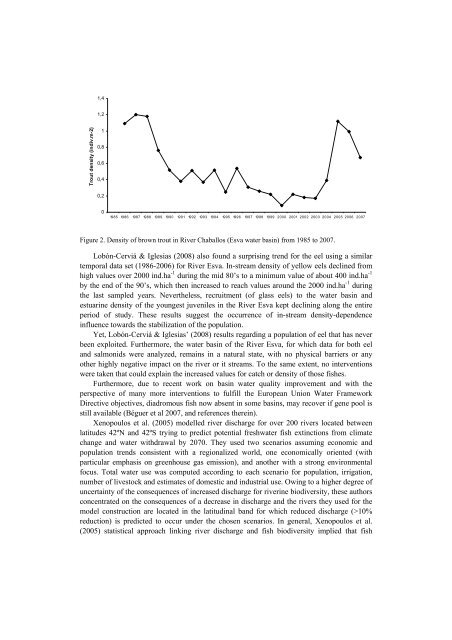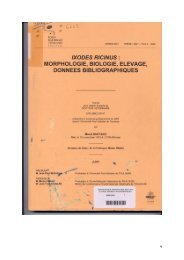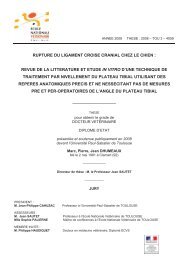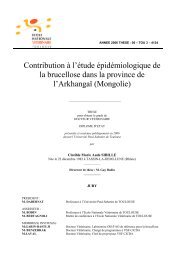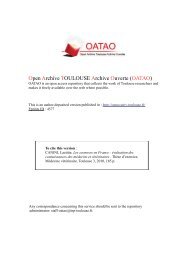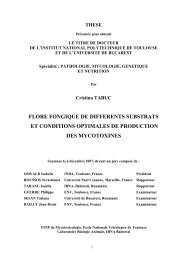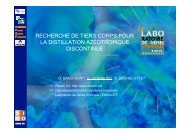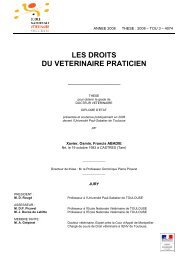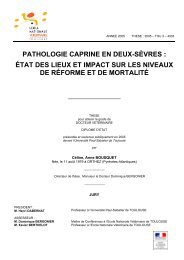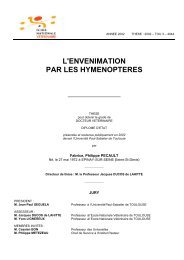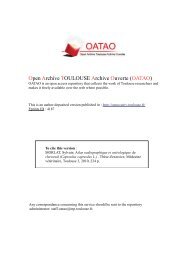PDF ( Author's version) - OATAO (Open Archive Toulouse Archive ...
PDF ( Author's version) - OATAO (Open Archive Toulouse Archive ...
PDF ( Author's version) - OATAO (Open Archive Toulouse Archive ...
You also want an ePaper? Increase the reach of your titles
YUMPU automatically turns print PDFs into web optimized ePapers that Google loves.
1,4<br />
1,2<br />
Trout density (indiv.m-2)<br />
1<br />
0,8<br />
0,6<br />
0,4<br />
0,2<br />
0<br />
1985 1986 1987 1988 1989 1990 1991 1992 1993 1994 1995 1996 1997 1998 1999 2000 2001 2002 2003 2004 2005 2006 2007<br />
Figure 2. Density of brown trout in River Chaballos (Esva water basin) from 1985 to 2007.<br />
Lobón-Cerviá & Iglesias (2008) also found a surprising trend for the eel using a similar<br />
temporal data set (1986-2006) for River Esva. In-stream density of yellow eels declined from<br />
high values over 2000 ind.ha -1 during the mid 80’s to a minimum value of about 400 ind.ha -1<br />
by the end of the 90’s, which then increased to reach values around the 2000 ind.ha -1 during<br />
the last sampled years. Nevertheless, recruitment (of glass eels) to the water basin and<br />
estuarine density of the youngest juveniles in the River Esva kept declining along the entire<br />
period of study. These results suggest the occurrence of in-stream density-dependence<br />
influence towards the stabilization of the population.<br />
Yet, Lobón-Cerviá & Iglesias’ (2008) results regarding a population of eel that has never<br />
been exploited. Furthermore, the water basin of the River Esva, for which data for both eel<br />
and salmonids were analyzed, remains in a natural state, with no physical barriers or any<br />
other highly negative impact on the river or it streams. To the same extent, no interventions<br />
were taken that could explain the increased values for catch or density of those fishes.<br />
Furthermore, due to recent work on basin water quality improvement and with the<br />
perspective of many more interventions to fulfill the European Union Water Framework<br />
Directive objectives, diadromous fish now absent in some basins, may recover if gene pool is<br />
still available (Béguer et al 2007, and references therein).<br />
Xenopoulos et al. (2005) modelled river discharge for over 200 rivers located between<br />
latitudes 42ºN and 42ºS trying to predict potential freshwater fish extinctions from climate<br />
change and water withdrawal by 2070. They used two scenarios assuming economic and<br />
population trends consistent with a regionalized world, one economically oriented (with<br />
particular emphasis on greenhouse gas emission), and another with a strong environmental<br />
focus. Total water use was computed according to each scenario for population, irrigation,<br />
number of livestock and estimates of domestic and industrial use. Owing to a higher degree of<br />
uncertainty of the consequences of increased discharge for riverine biodiversity, these authors<br />
concentrated on the consequences of a decrease in discharge and the rivers they used for the<br />
model construction are located in the latitudinal band for which reduced discharge (>10%<br />
reduction) is predicted to occur under the chosen scenarios. In general, Xenopoulos et al.<br />
(2005) statistical approach linking river discharge and fish biodiversity implied that fish


